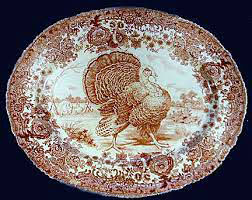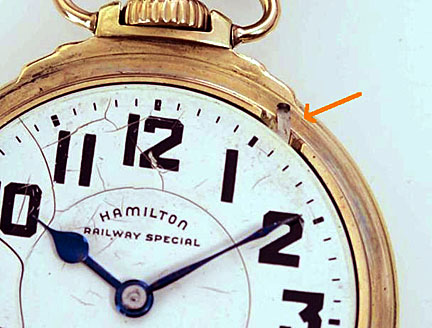 |
| Aladdin Teapot |
QUESTION: My mother was an avid tea drinker. When she was a young woman, she began buying old teapots at flea markets and yard sales. When I grew up and left to go on my own, I started giving her a teapot for her birthday. Over time, she amassed a collection of some 50 teapots. She passed away recently, and her collection has passed on to me. I chose the teapots I bought for her because of their unusual shapes, but I noticed that a good many of them seem to be marked for the Hall China Company. I’d like to continue adding to this collection. Why would so many have been made by Hall China? And as collectibles, are these teapots of any value?
ANSWER: Indeed, the Hall China Company is the king of teapots. Lots of people probably have one and don’t know it.
 |
| Gold Decorated Los Angeles Teapot |
 |
| Albany Teapot |
Robert Hall founded the Hall China Company after the dissolution of East Liverpool Potteries of East Liverpool, Ohio, in 1903. Taggert Hall, Robert’s son, became president following his father’s unexpected death in 1904. The company initially made jugs, toilet sets, and utilitarian whiteware. Robert T. Hall’s major contribution to the firm’s growth was the development of an economical, single-fire process for lead-free glazed wares introduced in 1911.
Robert Hall died just a year after founding his company. One of his eight children, Robert Taggart Hall, took it over and immediately began developments to introduce the single-fire process, which had first been used centuries earlier by Chinese potters during the Ming Dynasty from 1368 to 1644. His aim was to change from the two-firing manufacturing method, using first a biscuit firing and then the glaze firing. With the help of staff chemists and ceramic engineers, Hall experimented from 1904 until 1911, when the process was successful. The new process fused together the white body, color and glaze when it was fired at a temperature of 2,400 degrees Fahrenheit.
 |
| Pear Teapot |
The new glazes allowed the creation of brilliant colors never before seen on American china: 47 colors developed for the new process, which allowed for rapid expansion of the company and its product selections at the onset of World War I. After tepid sales of its new housewares lines in the 1910s, the company tried designing and selling decorated teapots. The teapot business was so successful that the company decided to expand it from the original three designs to a plethora of new shapes and colors. In the 1940s the teapot business began to dwindle. By the 1960s, probably due to the increased preference for coffee by the public, teapot sales had fallen to insignificance.
In the mid-1920s, Hall China began producing a range of ware exclusively for the Jewel Tea Company. Jewel started using Hall teapots as premiums, and then expanded the promotion to include its own line of distinctive dinnerware and kitchenware.
 |
| Globe Teapot |
Hall’s teapots were durable, non-porous, and unlike other types of china, didn’t craze. The Hall palette of colors included no fewer than 47 different variations over the years. The non-crazing process used to manufacture its pieces were made to emulate beautiful wares made in China during the Ming Dynasty, although the shapes and decor didn’t generally show any Asian influence.
Hall also produced novelty teapots shaped like cars, footballs, and doughnuts that remain popular with collectors although they're often difficult to find today. These include the popular Nautilus and Aladdin teapots.
 |
| Nautilus Teapot |
A Selection of Hall Teapots
Hall produced over 160 different shapes and color combinations of teapots. The first, the Gold Decorated Teapot line, also known as the Los Angeles teapot, was extremely popular.
 |
| Loc Angeles Teapot |
The second, the Boston teapot, which also began production in 1916, came in two styles, the Boston Knob, included here, and the Boston Sunken Lid. Both came in seven sizes from one cup to seven or eight cup. The Boston is one of Hall China Company’s earliest and most enduring styles. In 1916, the McCormack Tea Company purchased the Boston in the seven cup green. The seven cup green and brown Boston teapots were the first ones carried by the Jewel Tea Company in 1924.
 |
| Boston Teapots |
 |
| Philadelphia Teapot |
Another teapot Hall introduced in 1916 was the New York teapot and was one of Hall’s longest running styles, available from 1916 through 1989. It was originally and continually produced in nine different sizes for the Hall hotel ware line but was also added to the Gold Decorated line in 1920.
The Philadelphia teapot, produced during the 1920s, came in seven different sizes, ten, seven, six, five, four, three and one and a half cups. Later in that same decade, Hall introduced the Hollywood teapot which came in four, five, six and eight cup sizes.
 |
| Tea-for-Two Teapots |
From 1930 to 1996, Hall produced the Tea-for-Two, a combination teapot and a hot water pot, It’s distinguished from the Twin-Tea set by the sloped shape of the body, It can also be found as a Tea for Four set.
 |
| Musical Teapot |
From the late 1930s to the 1940s, Hall produced one of two Globe shaped teapots. The No-Drip is a Globe shape teapot with a different spout and decoration. The Globe teapot, introduced in the late 1930s, was usually found with the gold decoration pictured. By 1942 it was available in black, blue, brown, cadet, canary, delphinium, Dresden, emerald, green, green luster, ivory, marine, maroon, orchid, rose, turquoise and yellow.
Hall’s Musical teapot, made in the 1930s, wasn’t a success. The music box, which played “Tea for Two,” sat under the teapot in a “well,” held in place with a spring clip. Often, users would wash the teapot without removing the musical box, causing damage to the mechanism.
In 1937, Hall added the Streamline to the Gold Decorated teapot line. It featured the standard gold decoration around the top, edge, and spout found on other teapots in the line.
 |
| Streamline Teapot |
 |
| Doughnut Teapot |
The Automobile was one of the Hall China Company’s Novelty teapots introduced in 1938. Although it has a very unusual shape it was very popular. Introduced in 1938, the Basket was another Novelty teapot that included the Doughnut, the Birdcage, the Football, and the Basketball. In 1982, Hall was commissioned to make a caricature teapot of newly elected President Ronald Reagan. After a partial delivery the customer defaulted on the remaining order and subsequently the teapots were sold at the local Hall Closet store.
 |
| Automobile Teapot |
 |
| Rhythm Teapot |
Hall China produced some of its most beautifully designed teapots in the 1930s, many of which featured Art Deco styling. Introduced in 1938 in the 8-cup size with the 6-cup introduced the following year, the Airflow was colored marine in its standard design. It was perfectly balanced and was as simple to lift as a purse, easy to pour, plus the lid wouldn’t fall off.
Hall introduced the Rhythm teapot in 1939. Originally introduced as a gold decorated teapot with gold dots on the upper two drapes, it was later a part of the Hall American line and came in over 100 different colors. That same year, Hall produced a special souvenir teapot for the 1939 New York World's Fair.
 |
| 1939 New York World's Fair Teapot |
 |
| Twinspout Teapot |
Designer Oscar Ottoson invented the Twinspout teapot for which he received a patent in 1938. Hall China produced it for the Twinspout Pottery Company of New York. When a user removed the lid, there were two openings, the larger for the tea and the smaller for the hot water.
Produced from 1939 to 1963, the Aladdin teapot was one of Hall’s most popular shapes. It came with either a round or an oval opening, both with and without infusers, and in narrow and wide bodies.
 |
| Sani-Gold Teapot |
During the 1940s, Hall came out with the Sani-Gold teapot. It first appeared in the 1941 Hall China Special Catalog #4. The firm made it in three and six cup sizes, with grid in the spout to catch the tea leaves which was also shortened for easy cleaning.. The style, often referred to as “pert” was also easier to store.
Introduced in 1940, the Hook Cover teapot, produced only in the six cup size, had a lid that wouldn’t fall off when pouring. The body has a hook over which the lid fits, thus the name.
 |
| Hook Cover Teapot |
 |
| Windshield Teapot |
The Windshield teapot, introduced in 1941, had a collar similar to the one worn by Queen Elizabeth I of England.
From the mid 1950s through the 1960s, Hall produced the Parade teapot as one of its Gold Decorated teapots.. It had a hook cover lid and a non-slip handle.
Hall produced the E-Style Cameo Rose teapot, designed by J. Palin Thorley, another of Hall’s top designers, exclusively for the Jewel Tea Company from the 1950s to the 1970s. Another of its noted designers was Donald Schreckengost who designed the Pear teapot, first introduced in 1970.
 |
| E-Style Cameo Rose Teapot |
 |
| Airflow Teapot |
Hall China produced so many teapots during its existence that it’s nearly impossible for a collector to collect them all.
To read more articles on antiques, please visit the Antiques Articles section of my Web site. And to stay up to the minute on antiques and collectibles, please join the over 30,000 readers by following my free online magazine, #TheAntiquesAlmanac. Learn more about "Coffee--The Brew of Life" in the 2023 Summer Edition, online now. And to read daily posts about unique objects from the past and their histories, like the #Antiques and More Collection on Facebook.





















































